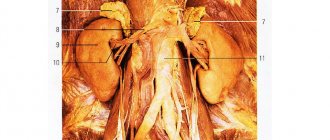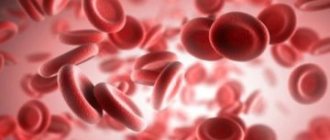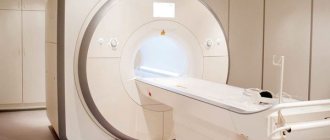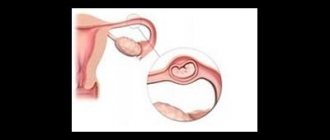Migraine is a neurological disease in which pain is most often localized in one half of the head, usually in the frontotemporal region. The patient, for no apparent reason, experiences long, painful headaches of a paroxysmal nature. As a rule, they are not associated with head injuries, stroke or brain tumors - the appearance of migraines is most often associated with changes in the functioning of blood vessels, which are best visualized with MR angiography.
Often, magnetic resonance imaging for migraine allows us to identify small lesions of a vascular nature, localized in the white matter, including subcortically (under the cerebral cortex).
Diagnosis of migraine and MRI
Diagnosis of migraine is usually carried out in two or three stages. The patient is examined and anamnesis collected during the initial consultation with a neurologist. Next, depending on the indications, the specialist prescribes treatment for the patient (for example, physical therapy and medications) or a series of examinations, based on which the doctor can make the correct diagnosis. Such studies include magnetic resonance imaging: it is an important diagnostic method, because the images obtained during the MRI study provide a complete picture of the location and nature of the identified pathology.
MRI of the brain is the main study in the diagnosis of migraine, which in most cases is irreplaceable. MRI scanning is carried out in three mutually perpendicular projections, thanks to which the radiologist can identify various pathological processes and see any, even the smallest, changes in the brain. The high contrast of the resulting images makes it possible to evaluate in detail the cortex and white matter of the brain, the basal subcortical ganglia, large arteries included in the slice, the brain stem and the contents of the posterior cranial fossa (which in turn is poorly visualized on CT). MRI for migraine is required by a neurologist to make a clinical diagnosis and plan effective treatment. Often, the doctor additionally prescribes magnetic resonance angiography.
Classification of hemicrania depending on symptoms
- Migraine headache without aura is defined by episodic headaches without neurological deficits.
- Cervical migraine with severe headaches due to impaired blood flow through the vertebral artery.
- Paroxysmal chronic, which is characterized by short-term pain repeated several times a day.
- The ocular one, which lasts no more than half an hour, appears due to circulatory disorders in the occipital part of the cerebral cortex.
- Ophthalmoplegic with characteristic gas motor disorders due to compression of the gas motor nerve and spasms of the artery supplying the nerve.
- Retinal with characteristic attacks of transient blindness due to spasms of retinal vessels.
- Afactual with speech disorders during severe pain.
- Basilar (rare), characterized by tinnitus, visual disturbances, incoordination, dizziness, loss of consciousness and severe prolonged pain. Most often, this variety occurs during puberty in girls.
- Abdominal, accompanied by nausea, diarrhea, vomiting and severe abdominal pain, occurs only in children.
- Hemplegic with short attacks, weakness in the body and limbs.
- “Beheaded” is distinguished by visual disturbances and is difficult to diagnose.
Only a qualified doctor after an examination can answer the patient’s question as to why the migraine appeared.
How is a migraine different from a headache?
It is very important to differentiate migraine from headache, which, as a rule, signals hidden pathologies.
Migraine, as we have already said, is most often a consequence of deterioration of blood supply to the brain due to vascular spasm or due to dilation of cerebral vessels with a subsequent increase in vascular permeability, while the following conditions can be the cause of headache:
- increase and decrease in blood pressure;
- cerebral aneurysm (minor and rare painful sensations may be a sign of the presence of an aneurysm);
- swelling (persistent headache accompanied by vomiting without previous nausea).
From the above, it becomes clear that mistaking a headache for a migraine in some cases can have undesirable consequences, and the time necessary for adequate treatment may be missed. It is also known that patients experiencing migraine usually describe it as throbbing in the temples, but throbbing headaches can be caused not only by migraines, but also by ear infections and sinusitis. Consequently, only an experienced clinician (neurologist) will be able to clinically differentiate migraine from headaches of other origins.
If the attending physician wants to exclude or confirm the presence of a brain tumor as a possible cause of the headache, then the patient may be prescribed a contrast-enhanced MRI. In the presence of a tumor, MRI allows one to identify, localize, and evaluate the structure, size and relationship of the tumor with surrounding tissues and midline structures of the brain.
One of the advantages of the MRI method is the absence of harmful ionizing radiation, which makes the examination absolutely safe for the patient’s health.
It should be noted that many diseases, including those that can lead to disability, at the initial stage have only one pronounced symptom - headache, which makes it possible to suspect the disease. But even in these cases, an MRI will help identify the cause of the headache: the scan visualizes structural changes in the brain that are characteristic of each individual disease, which makes it possible to predict the course of the disease and begin treatment on time.
Migraine
2622 January 10
IMPORTANT!
The information in this section cannot be used for self-diagnosis and self-treatment.
In case of pain or other exacerbation of the disease, diagnostic tests should be prescribed only by the attending physician. To make a diagnosis and properly prescribe treatment, you should contact your doctor. Headache is one of the most common complaints of patients when visiting a family doctor or neurologist. The cause of headache syndrome can be a number of factors.
Headaches vary in duration, nature, and intensity. According to their origin, they are divided into primary and secondary. Primary headaches are an independent pathology in which headache is the first and main complaint. These include migraine, tension headache, and cluster headache. The cause of secondary headaches is diseases that arise as a result of damage to cranial structures (traumatic brain injury, tumors, brain infections, vascular pathology) or that appear for the first time in connection with another disease. This article will discuss one of the forms of primary headache, namely migraine.
The most common forms of migraine
Migraine is a type of headache that is characterized by periodically recurring attacks of throbbing headaches, often with one-sided localization and sufficient intensity that it makes a person’s daily activities difficult.
Migraines may worsen when climbing stairs or during physical activity. This pain is accompanied by at least one of the following symptoms: nausea, vomiting, increased sensitivity to light and sound. The duration of the attack usually ranges from 4 hours to 3 days. These signs are characteristic of migraine without aura (80% of cases). Migraine with aura (up to 20% of cases) includes, in addition to what is described above, a complex of reversible neurological symptoms preceding the attack. These include:
- completely reversible visual disturbances (flickering spots, stripes, blurred vision);
- completely reversible sensory symptoms (tingling sensation, numbness);
- completely reversible speech impairment;
- completely reversible distortions in the perception of the size and shape of objects.
Causes of migraine attack
It has been proven that migraine headaches are based on neurogenic inflammation and secondary dilatation (persistent dilatation) of blood vessels.
In most patients suffering from migraine, there is an indication of the familial nature of the disease.
The occurrence of migraine depends on the level of female sex hormones, so women suffer from it more often.
In patients suffering from migraine, the excitability of brain cells is increased, which increases when exposed to external and internal migraine provocateurs. Most often, attacks are caused by emotional stress, weather changes, menstruation, hunger, lack of sleep or excess sleep, certain foods (chocolate, citrus fruits, bananas, fatty cheeses) and alcohol intake. In response to stimulation of brain structures, specific proteins are released that cause dilation of brain vessels and activation of pain receptors in their walls. Pain impulses enter the sensory (perceptive, sensitive) cortex of the brain, which forms the sensation of throbbing pain.
What diseases can cause headaches?
Migraine refers to a primary headache when there are no diseases that could provoke an attack. However, secondary headaches, that is, those caused by other diseases, can resemble migraines.
Therefore, the doctor usually conducts a thorough examination of the patient in order to clarify the cause of migraine-like conditions, since the patient’s treatment tactics depend on this.
The following are possible sources of secondary headaches:
- head and/or neck injury;
- vascular lesions of the cervical spine;
- non-vascular intracranial lesions (for example, brain tumors, intracranial hypertension of various origins);
- taking medications and/or stopping them;
- infections;
- violation of the structures of the skull and face;
- mental illness.
Which doctors should I contact if I develop a migraine?
First of all, you should contact your general practitioner. As a rule, migraine does not reveal any changes in somatic and neurological status. If they are detected, the doctor will give a referral for laboratory and instrumental examinations and consultation with specialized specialists: , , , dentist, otolaryngologist to exclude/confirm secondary headaches.
Diagnosis of migraine and additional examinations if secondary headache is suspected
A detailed questioning of the patient is the basis for correct diagnosis. If a migraine is suspected, the doctor may prescribe laboratory and instrumental examinations to the patient, which he selects individually depending on the suspected causes of the headache.
Clinical blood test with a detailed leukocyte formula. One of the main laboratory tests for quantitative and qualitative assessment of blood cells. Includes a cytological examination of a blood smear with counting the content of different forms of leukocytes and determination of the erythrocyte sedimentation rate and smear microscopy in the presence of pathological changes.
Migraine prevention
First of all, a patient suffering from headaches will be advised to lead a healthy lifestyle: good sleep at night and physical activity during the day will reduce the frequency of headache attacks. Regular and nutritious nutrition is also necessary, and it is better to minimize the consumption of alcoholic beverages, coffee and chocolate.
Headaches can be a symptom of many different medical conditions, some of which can have serious consequences. Vascular diseases, which often cause painful sensations in the head, can be successfully treated with timely consultation with a doctor.
However, if the patient does not have the opportunity to see a doctor first and then undergo an MRI diagnosis, he can immediately sign up for an MRI of the brain. If any changes are detected in the brain, our radiologist will comment on them and, if necessary, recommend what specialty you should see.
And if you still doubt whether you need to do an MRI for a headache, we recommend that you read the article about in what cases MRI and CT of the brain are prescribed.
What will an MRI show for migraines?
Based on statistics, the most common reason people turn to a neurologist is headaches and migraines. Factors that contribute to migraines can be divided into three categories: functional and organic. When answering the question whether an MRI will show migraine, you need to understand that only organic factors of formation are displayed on MR images. Organic anomalies that cause pain in the head include:
- Malignant and benign tumors;
- Hydrocephalus;
- Congenital brain pathologies;
- Sinusitis;
- Aneurysms;
- Brain hemorrhages;
- Meningitis.
Sometimes using MRI it is not possible to determine the cause of the disease, then the attending physician is guided by various indirect signs for diagnosis.
A disturbance in the cerebral circulatory system can also cause migraines. In this situation, MRI in angio mode is prescribed. For higher effectiveness of the procedure, it is best to conduct an MRI examination at the time of a headache attack. Only in this case can one reliably assess disturbances in the circulatory system and the intensity of blood flow.
At the time of the procedure, the specialist can diagnose cervical artery syndrome, which can affect both vessels or affect only one side. This syndrome is the cause of pulsating headaches that occur due to compression of the cervical artery, and the pain can intensify when the head moves. The cause of a compressed cervical artery may be previous injuries.
What MRI method is used for migraine?
When answering the question of which MRI will be used for migraine, it is necessary to understand that the MRI examination method is prescribed only by a neurologist after a thorough examination of the patient. The best option is a comprehensive examination of the head using MRI of the brain in combination with angiography of the vessels of the head and neck. Only with a comprehensive examination can you get a complete picture of the condition of the tissues and structure of the brain, determine disorders of the circulatory system and exclude the possibility of malignant tumors.











